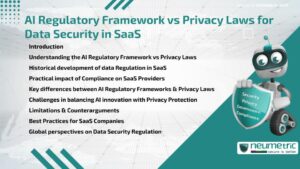Table of Contents
ToggleIntroduction
The concept of a Risk Quantification methodology for Compliance is central to how Corporations manage evolving Threats & meet Regulatory Standards. Compliance Programs require not only Policies & Controls but also measurable Evidence of effectiveness. By quantifying Risks, Organisations can prioritise Resources, align with Regulations & demonstrate accountability to Regulators & Stakeholders. This article explores why Quantification is essential, how methodologies are structured, the challenges involved & practical steps Companies can take to integrate Quantification into their Compliance Programs.
Understanding Risk Quantification in Compliance Programs
Risk Quantification is the process of assigning measurable values to Potential Threats. In Compliance, it helps translate abstract Risks-such as Data Privacy Violations or Financial misreporting-into clear Metrics. For example, a Risk may be expressed in terms of Financial impact, Probability of occurrence or Reputational cost. Quantification provides a common language for Executives, Regulators & Compliance teams to evaluate priorities objectively.
Why Organisations need a Risk Quantification Methodology for Compliance?
Corporate Compliance Requirements are more complex than ever. Regulations such as the General Data Protection Regulation [GDPR] & the Sarbanes-Oxley Act [SOX] demand Evidence-based Controls. A Risk Quantification methodology for Compliance provides several advantages:
- Clear prioritisation of Risks by Severity & Likelihood.
- Better allocation of Resources to areas with the highest Impact.
- Demonstration of Compliance readiness to Regulators & Auditors.
- Improved communication with Stakeholders using standardised Risk Metrics.
Without Quantification, Compliance Programs Risk becoming reactive Checklists rather than proactive Management Systems.
Key Components of a Risk Quantification Framework
An effective methodology often includes the following elements:
- Risk identification: Mapping all relevant Risks tied to Regulatory requirements.
- Data collection: Gathering historical Incident Records, Audit Findings & External Benchmarks.
- Probability modeling: Estimating the Likelihood of Risks using Statistical or Expert judgment methods.
- Impact Assessment: Measuring potential outcomes such as Financial loss, Legal penalties or Reputational harm.
- Aggregation: Combining Individual Risks into an overall Risk profile for the Organisation.
Each of these components ensures that Compliance-related Risks are consistently & transparently evaluated.
Common Approaches to measuring Risk
Organisations adopt different Models depending on their Size & Regulatory environment:
- Quantitative Models: Use Statistical analysis & Financial modeling to estimate losses.
- Semi-Quantitative Models: Apply Scoring Systems that assign relative weights to Risks.
- Qualitative Assessments: Use expert input where precise data is lacking, often expressed in descriptive terms.
A blended approach is often most effective, combining Numerical analysis with Expert interpretation.
Challenges & Limitations in applying Quantification
While Risk Quantification offers clarity, it comes with challenges:
- Limited availability of reliable data for certain Compliance Risks.
- Potential overconfidence in Numerical Models that oversimplify complex issues.
- Difficulty in capturing intangible Impacts like Reputational damage.
- Resistance from Stakeholders unfamiliar with Technical Models.
Acknowledging these limitations prevents Organisations from misusing or misrepresenting Quantification results.
Balancing Quantitative & Qualitative Risk Assessments
Compliance Programs should not view Quantification as a replacement for Qualitative Assessments. Numbers provide rigor, but context is equally important. For instance, while a Financial model may suggest low monetary loss, a small breach of Health Data could carry significant Reputational harm. Balancing both perspectives ensures that Compliance Risk Programs remain comprehensive & practical.
Practical Steps to implement a Risk Quantification Methodology for Compliance
Organisations looking to embed Quantification into Compliance Programs can follow these steps:
- Define Compliance Objectives clearly, aligning with Regulatory requirements.
- Select an appropriate Model–Quantitative, Semi-Quantitative or blended-based on available Data.
- Develop Metrics & Thresholds to guide decision-making.
- Integrate tools & technology for Data collection & Analysis.
- Train Compliance & Risk Teams to interpret & apply results.
- Review & refine the methodology regularly in response to Regulatory changes & Audit feedback.
By approaching Quantification systematically, companies can embed measurable Accountability within Compliance efforts.
Takeaways
- Risk Quantification methodology for Compliance helps organizations move beyond guesswork.
- It strengthens decision-making by providing Data-driven Insights.
- It improves Resource allocation across Risk Programs.
- It demonstrates accountability to Regulators & Stakeholders.
- Challenges exist in applying Risk Models effectively.
- The most effective approach combines Numerical analysis with Expert judgment.
FAQ
What is a Risk Quantification methodology for Compliance?
It is a structured approach to measuring & evaluating Risks that affect an organisation’s Compliance obligations using Quantitative & Qualitative methods.
Why is Risk Quantification important in Compliance Programs?
It ensures Risks are prioritized objectively, resources are directed efficiently & Regulatory requirements are demonstrably met.
Can all Compliance Risks be quantified?
Not always. Some Risks, like Reputational harm, are difficult to measure precisely, but Approximations & Expert judgments still provide value.
What Models are used to quantify Compliance Risks?
Organisations often use Quantitative Models, Semi-Quantitative Scoring or Qualitative Assessments depending on Data availability & Regulatory needs.
How does Quantification support Regulatory Audits?
It provides measurable Evidence of Risk Management practices, showing Regulators that the Organisation actively monitors & prioritizes Compliance Risks.
What are the main challenges in quantifying Compliance Risks?
Challenges include lack of Data, complexity of Models, intangible Impacts & potential resistance from Stakeholders.
Should Qualitative Assessments be ignored if Quantification is used?
No. A balanced approach is best, combining measurable Data with Expert interpretation for a comprehensive view of Compliance Risks.
Need help for Security, Privacy, Governance & VAPT?
Neumetric provides organisations the necessary help to achieve their Cybersecurity, Compliance, Governance, Privacy, Certifications & Pentesting needs.
Organisations & Businesses, specifically those which provide SaaS & AI Solutions in the Fintech, BFSI & other regulated sectors, usually need a Cybersecurity Partner for meeting & maintaining the ongoing Security & Privacy needs & requirements of their Enterprise Clients & Privacy conscious Customers.
SOC 2, ISO 27001, ISO 42001, NIST, HIPAA, HECVAT, EU GDPR are some of the Frameworks that are served by Fusion – a SaaS, multimodular, multitenant, centralised, automated, Cybersecurity & Compliance Management system.
Neumetric also provides Expert Services for technical security which covers VAPT for Web Applications, APIs, iOS & Android Mobile Apps, Security Testing for AWS & other Cloud Environments & Cloud Infrastructure & other similar scopes.
Reach out to us by Email or filling out the Contact Form…





